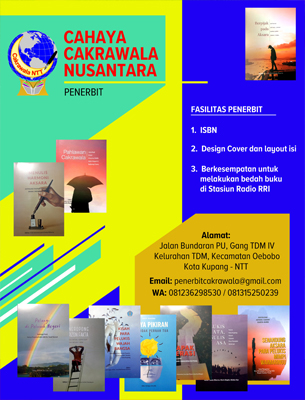CAKRAWALANTT.COM - As an international
language, English is used by people, in general, to communicate or interact
with other people from various countries. At the end of the 20th century,
English has become a tool of communication as the first language and also a
second language (Harmer, 2007). In the field of the Indonesian education
system, English has become one of the main courses that must be taken by
students. It has been taught in various schools such as elementary school,
middle school, and even in college.
There might be one
million words that are categorized as English (Nobert, 2000). The daily
vocabularies that can be found in playing the online game namely lack, skill,
character, ranked mode, or booyah. Some vocabularies are also appeared
when we do online shopping such as cash, delivery, and payment, discount, or
sold out.
In the process of
learning English, specifically in the first year of language class, SMAS 1
Katolik John Paul II, the students often find difficulties in speaking and
generalizing their ideas. It has become a habit for students to use translator
apps and translate word by word so that the results are not optimal. The root
problem of this situation is the students have limited knowledge of vocabulary
and they tend to be unmotivated to learn English. They have learned much
vocabulary but still do not know when to use it and how to comprehend it in the
right context. Therefore, they must know how to apply the words based on the
context (Harmer, 2007).
The same problem is
also faced by students when they are learning a narrative text. The narrative
text is the type of text which explains a story that happened in the past
intending to entertain the readers (Gerot & Wignell, 1994). Fabel, legend,
myth, and fairytale can be taken as examples. Based on this definition, the
vocabulary of narrative text is various enough and the verbs are also changing
due to the adverb of time. For instance, if the students usually use the words
know, go, cook, teach, and ask, they will know the changing verbs. Those words
will be changed into knew, went, cooked, taught, and asked.
Furthermore, there are
some ways to improve English vocabulary competency. One of them is using an
English learning video. Harmer (2001) stated that an English learning video has
become a general process in learning English. It can be the beginning step in
learning communication skills, writing skills, and discussion skills
(Scrivenner, 2005).
According to the book written by Harmer (2001), he emphasized the teaching methods, teaching materials, and learning literature. The writer further applied Harmer’s (2001) techniques such as fast forward, silent viewing, freeze frame, and partial viewing.
1) Fast forward
Fast forward is the
first technique where the teacher plays a video quickly. Then, the teacher can
ask the students about the important points of the video or ask them to guess
conversations of the actors inside. By doing this, the students will be able to
identify vocabulary used by the actors in that video.
2. 2) Silent viewing
Silent viewing is a
technique of watching video without audio. At the end of the video, the
students are required to guess what the speakers are saying in the video based
on the scene they make. After that, the teacher can replay the video using
audio so the students can see whether or not their answers are right.
3. 3) Freeze frame
In this stage, the
teacher controls the video by pausing it and asking the students to retell the
story and guess what will be happened next. The students are required to be
creative in telling the next story. Then, the teacher can continue the video.
This technique can be repeated until the end of the video.
4. 4) Partial viewing
The last is the partial
viewing technique. The teacher can only play half of the video and close
another video. In this situation, the students are asked to guess the
activities made by the actors. Then, the teacher can use cards/papers to close
half of the video. In this case, the students have to give vocabulary in the
form of verbs.
The process of expanding English vocabulary through watching a
narrative text learning video will be effective if the teachers apply the
teaching techniques proposed by Harmer. Those techniques include fast forward,
silent viewing, freeze farmer, partial viewing. Moreover, teachers can become
the facilitator to accommodate the students in comprehending how to use
vocabulary in various contexts.
Written by: Agata Helena Eman, S.Pd
Translated by: Ira Luik (red)

















0 Comments